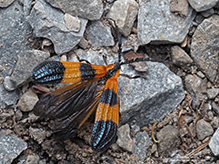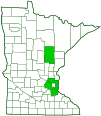banded net-wing beetle
(Calopteron discrepans)
Conservation • Description • Habitat • Ecology • Distribution • Taxonomy
|
|
||||||||||||||
Description |
Banded net-wing beetle is a brightly colored, medium sized beetle. It occurs in the United States east of the Great Plains, in southern Ontario and Quebec Canada, in Mexico, and in Central America. The larvae live mostly in rotten logs and under loose bark, sometimes in the soil or in leaf litter. Their diet is unclear. According to some authors they are predaceous, but according to others they feed on fungi, slime molds, or fermenting plant juices. Adults are short lived. They are active in late spring and early to mid-summer in moist woodlands. They are believed to feed on flower nectar. They can often be seen during the day in large numbers on vegetation. Adults are ⅜″ to 9⁄16″ (9.25 to 14.5 mm) in length. The body is soft, orange and black, somewhat triangular when viewed from above, and flattened when viewed from the side. The head is black and small. When retracted, it is covered up to the front margin of the eyes by the plate on the upper side of the first segment of the thorax (pronotum). The eyes are of moderate size and are spaced well apart. The antennae are black, strongly flattened, and long, more than half as long as the body. They have 11 segments, and they are strongly sawtoothed (serrate) on both sexes. The second segment is black, very short, and much wider than long. It is difficult to see on most photos because it is partially concealed by the tip of the first segment. The third segment is longer than wide and is somewhat shorter than the fourth segment. The underside is black on all segments. The mouthparts are directed downward, nearly vertical, and are partially covered by the pronotum. The finger-like appendages on the under-jaws (maxillae) have six segments. The last segment is large and much wider than long The pronotum is black, flattened, and bell shaped. The sides are narrowly but distinctly flattened (margined) and orange. The small plate between the wing bases (scutellum) is black. The undersides of the thorax and abdomen are entirely black, including the plate on the third thoracic segment (metasternum). The wing covers (elytra) are long, extending well beyond the tip of the abdomen. They are evenly broadened from the base to about three-fourths their length, then broadly rounded at the tip. Each elytron has distinct longitudinal ridges connected by numerous less distinct cross ridges. The even numbered longitudinal ridges are higher than the odd numbered ridges. The elytra are orange with the rear two-fifths black, and with a broad, black, horizontal band before the middle (median band). The median band tends to be broad all the way to the lateral margins. It has a narrow extension on the inner margin to the base (sutural extension). The sutural extension is expanded at the base, widest near the scutellum. It is sometimes reduced to a narrow dash by the scutellum. It is rarely entirely absent. The legs are stout, strongly flattened, and mostly or entirely black. The undersides are sometimes orangish. The basal segments (coxae) of all legs are widely separated. The last part of each leg (tarsus), corresponding to the foot, has five segments. The first four segments are densely hairy below. The last segment has a pair of claws at the tip. The claws are not toothed or divided, and they are equal in length. |
Size |
Total length: ⅜″ to 9⁄16″ (9.25 to 14.5 mm) |
Similar Species |
Reticulated net-wing beetle (Calopteron reticulatum) is very similar in appearance. The median band tends to narrow near the lateral margins, and the extension is parallel sided. It is much more common. |
Habitat |
Moist woodlands |
Ecology |
Season |
Late spring and early to mid-summer |
Behavior |
|
Life Cycle |
Large numbers of mature larvae congregate tightly together to pupate, creating a shingled mass of up to 600 or more pupae on a tree trunk. |
Larva Food |
Uncertain; either fungi, slime molds, or fermenting plant juices; or predaceous |
Adult Food |
Probably flower nectar |
Distribution |
||
|
Sources The Lycidae of the United States and Canada. Iv. The Tribe Calopterini (Coleoptera) John Wagener Green Transactions of the American Entomological Society (1890-), vol. 78, No. 1 (Mar., 1952), pp. 1-19 (21 pages) |
|
| 3/20/2024 | ||
Occurrence |
||
|
||
Taxonomy |
|
Order |
Coleoptera (Beetles) |
Suborder |
Polyphaga (Water, Rove, Scarab, Long-horned, Leaf, and Snout Beetles) |
Infraorder |
Elateriformia |
Superfamily |
Elateroidea (click, firefly and soldier beetles) |
Family |
Lycidae (net-winged beetles) |
Subfamily |
Lycinae |
Tribe |
Calopterini |
Genus |
Calopteron |
Subordinate Taxa |
|
|
|
Synonyms |
|
|
|
Common Names |
|
banded net-wing beetle two-banded net-wing beetle |
|
Glossary
Coxa
The first (most proximal) segment of the legs of most arthropods, including all insects, spiders, and crustaceans, and most arachnids. It attaches the leg to the body and connects to the trochanter. Plural: coxae.
Elytra
The hardened or leathery forewings of beetles used to protect the fragile hindwings, which are used for flying. Singular: elytron.
Maxillae
Paired mouth structures of arthropods located immediately behind the mandible and used for tasting and manipulating food. “Under-jaws”.
Pronotum
The exoskeletal plate on the upper side of the first segment of the thorax of an insect.
Scutellum
The exoskeletal plate covering the rearward (posterior) part of the middle segment of the thorax in some insects. In Coleoptera, Hemiptera, and Homoptera, the dorsal, often triangular plate behind the pronotum and between the bases of the front wings. In Diptera, the exoskeletal plate between the abdomen and the thorax.
Tarsus
On insects, the last two to five subdivisions of the leg, attached to the tibia; the foot. On spiders, the last segment of the leg. Plural: tarsi.
Visitor Photos |
||
Share your photo of this insect. |
||
This button not working for you? |
||
Alfredo Colon |
||
 |
|
|
MinnesotaSeasons.com Photos |
||
|
||
|
||

Slideshows |
|

Visitor Videos |
||
Share your video of this insect. |
||
This button not working for you? |
||
|
Other Videos |
||
Stripped bug is a Banded Net-Winged Beetle. 🐝🐝🌼⭐ |
About
Sep 24, 2023 The Banded Net-Winged Beetle, Calopteron discrepans, a species of net-winged beetle in the family Lycidae. The adult Banded Net-Winged Beetle is 1 to 1.5 cm. Nature photography, Philosophy, Affirmations, Declarations, Meditations, and musings while hiking Perkin's Farm Conservation Area, Worcester, MA, Massachusetts, New England USA Earth Filmed using Google Pixel 7 Pro |
Does Banded Net-Winged Beetle, look like a Lanternfly? |
About
Sep 5, 2023 The Banded Net-Winged Beetle, Calopteron discrepans, a species of net-winged beetle in the family Lycidae. The adult Banded Net-Winged Beetle is 1 to 1.5 cm. |

Created: 3/21/2024 Last Updated: © MinnesotaSeasons.com. All rights reserved. |


